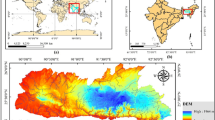Abstract
From September 16 to September 20, 2010, a cold weather front went across Slovenia. A heavy 4-day rainfall totaling between 300 and 520 mm caused large floods and triggered numerous rainfall-induced landslides. The damage due to the floods and landslides is estimated over 250 million Euros. One of the largest landslides covering the area of approximately 15 ha was triggered on flysch bedrock, just below a limestone overthrust zone. The sliding material properties, the inclinations of the slope, and the water catchment area indicate that the landslide may transform into a fast moving debris flow. The necessary protective measures were taken to protect inhabitants and the infrastructure against the disaster. The Stogovce landslide is one of the numerous rainfall-induced landslides that have occurred in Slovenia on flysch bedrock in the last 10 years. It proves that landslide risk on flysch territory is increasing. Special program of monitoring and protective measures will have to be developed in near future to protect densely populated areas against landslides as a consequence of weather extremes.












Similar content being viewed by others
References
ARSO (2010) Hidrološko poročilo o povodnji v dneh od 17. do 21. septembra 2010 (A hydrologic report on large floods on days from September 17 to 19, 2010-in Slovenian). http://www.arso.gov.si/vode/poro%c4%8dila%20in%20publikacijePoplave%2017.%20-%2021.%20september%202010.pdf. Accessed 28 November 2010
Blteanu D, Chendeş V, Sima M, Enciu P (2010) A country-wide spatial assessment of landslide susceptibility in Romania. Geomorphology 124(3–4):102–112
Borgatti L, Corsini A, Barbieri M, Sartini G, Truffelli G, Caputo G, Puglisi C (2006) Large reactivated landslides in weak rock masses: a case study from the Northern Apennines (Italy). Landslides 3(2):115–124. doi:10.1007/s10346-005-0033-9
Buser S (1973) Basic geological map of SFRJ 1:100,000, sheet Gorica, Savezni geološki zavod, Beograd, Yugoslavia
Christaras B (1997) Landslides in iliolitic and marly formations. Examples from north-western Greece. Eng Geol 47:57–69
Damm B, Terhorst B (2010) A model of slope formation related to landslide activity in the Eastern Prealps, Austria. Geomorphology 122(3–4):338–350
De Vita P, Reichenbach P, Guzzetti F, Bathurst JC, Borga M, Crosta G, Crozier M, Glade T, Hansen A, Wasowski J (1998) Rainfall-triggered landslides: a reference list. Env Geol 35(2–3):219–233
Duman T, Can Y, Emre T, Kecer O, Dogan M, Ates A, Durmaz S (2005) Landslide inventory of northwestern Anatolia. Turkey Eng Geol 77:99–114
Guzzetti F, Peruccacci S, Rossi M, Stark CP (2007) Rainfall thresholds for the initiation of landslides in central and southern Europe. Meteorol Atmos Phys 98(3–4):239–267. doi:10.1007/s00703-007-0262-7
Guzzetti F, Peruccacci S, Rossi M, Stark CS (2008) The rainfall intensity–duration control of shallow landslides and debris flows: an update. Landslides 5:3–17
Hradecký J, Pánek T (2008) Deep seated gravitational slope deformations and their influence on consequent mass movements (case studies from the highest part of the Czech Carpathians). Nat Hazards 45:235–253
Hradecký J, Pánek T, Klimová R (2007) Landslide complex in the northern part of the Silesian Beskydy Mountains (Czech Republic). Landslides 4:53–62. doi:10.1007/s10346-006-0052-1
Logar J, Fifer Bizjak K, Kočevar M, Mikoš M, Ribičič M, Majes B (2005) History and present state of the Slano blato landslide. Nat Hazards Earth Syst Sci 5(3):447–457
Majes B, Petkovšek A, Logar J (2002) The comparison of material properties of debris flows from Stože, Slano blato and Strug landslides. Geologija 45(2):457–463 (in Slovenian with English abstract)
Margielewski W (2006) Structural control and types of movements of rock mass in anisotropic rocks: Case studies in the Polish Flysch Carpathians. Geomorphology 77:47–68
Micu M, Balteanu D (2009) Landslide hazard assessment in the Curvature Carpathians and Subcarpathians, Romania. Z Geomorphol 53:31–47
Mikoš M (2011) Public perception and stakeholder involvement in the crisis management of sediment-related disasters and their mitigation: The case of the Stože debris flow in NW Slovenia. Integr Env Assess Manag. 7(2):216-227 doi:10.1002/ieam.140
Mikoš M, Majes B (2010) Mitigation of large landslides and debris flows in Slovenia, Europe. In: Werner ED, Friedman HP (eds) Landslides: causes, types and effects, 1st edn. Nova, New York, pp 105–131
Mikoš M, Petkovšek A, Majes B (2009) Mechanisms of landslides in over-consolidated clays and flysch: activity scale and targeted region: national. Landslides 6(4):367–371
Pánek T, Hradecký J, Smolková V, Šilhán K, Minár J, Zernitskaya V (2010) The largest prehistoric landslide in northwestern Slovakia: Chronological constraints of the Kykula long-runout landslide and related dammed lakes. Geomorphology 120(3–4):233–247
Placer L, Vrabec M, Celarc B (2010) The bases for understanding of the NW Dinarides and Istria Peninsula tectonics. Geologija 53(1):55–86
Poljak M (1986) The structural evolution of the Slovene outer Dinarides in Tertiary and Quaternary. XI Cong Geol Yugosl 3:299–322
Sabatakakis N, Koukis G, Mourtas D (2005) Composite landslides induced by heavy rainfalls in suburban areas: City of Patras and surrounding area, western Greece. Landslides 2(3):202–211. doi:10.1007/s10346-005-0002-3
Santaloia F, Cancelli A (1997) Landslide evolution around Mt. Campastrino (Northern Apennines, Italy): a complex and composite gravitational movement. Eng Geol 47:217–232
Zorn M, Komac B (2009) The importance of landsliding in a flysch geomorphic system: the example of the Goriska brda Hills (W Slovenia). Z Geomorphol 53:57–78
Acknowledgments
The field investigation described in the paper was conducted by a research group called together by the Commander of the Civil Defense of the Ajdovščina Municipality, Mr. Igor Benko. His help is gratefully appreciated.
The rainfall and discharge data were kindly made available by the Environmental Agency of the Republic of Slovenia. The research conducted was partially financially supported by the Slovenian Research Agency grant Nr. P2-0180 “Hydrotechnics, hydraulics, and geotechnics” and the PhD grant No. 1000-08-310068 (Maček M).
Author information
Authors and Affiliations
Corresponding author
Rights and permissions
About this article
Cite this article
Petkovšek, A., Fazarinc, R., Kočevar, M. et al. The Stogovce landslide in SW Slovenia triggered during the September 2010 extreme rainfall event. Landslides 8, 499–506 (2011). https://doi.org/10.1007/s10346-011-0270-z
Received:
Accepted:
Published:
Issue Date:
DOI: https://doi.org/10.1007/s10346-011-0270-z




